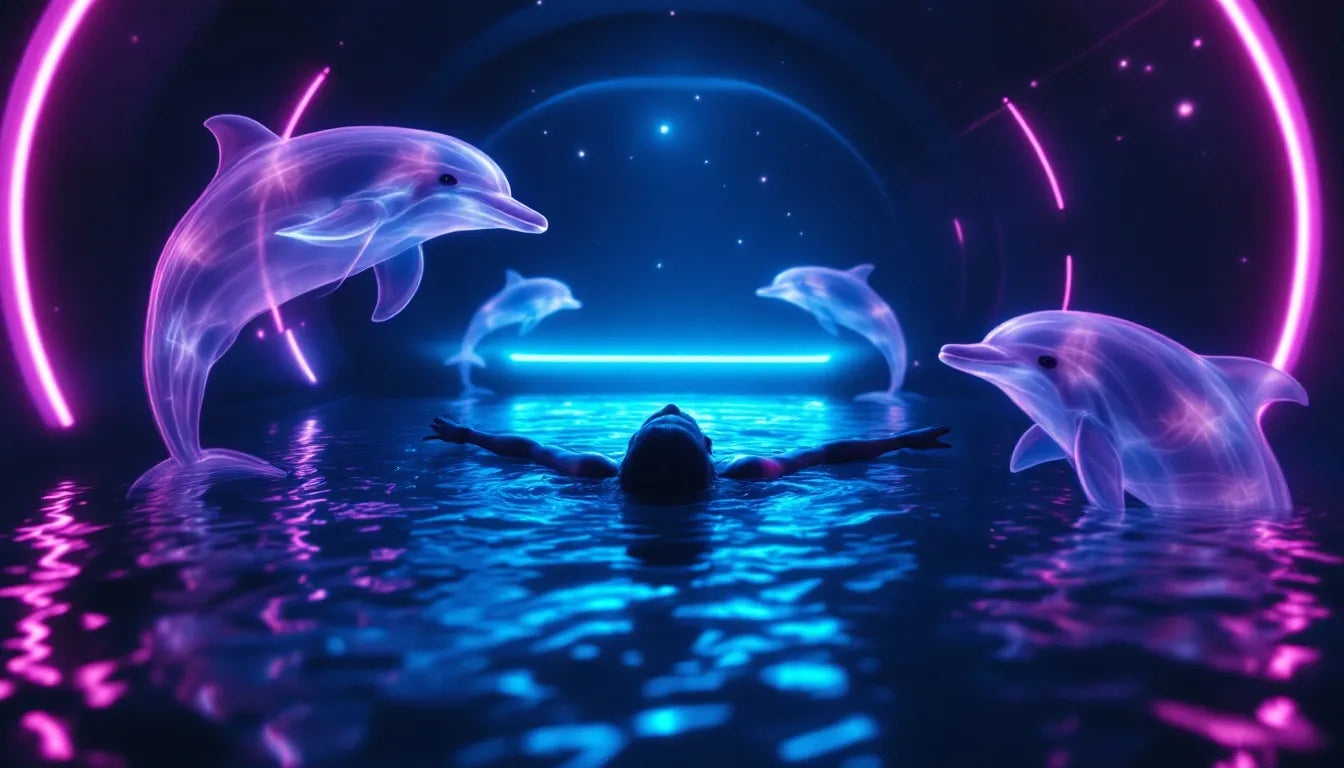
LSD and Isolation Tanks: The Mind-Bending Experiments of John C. Lilly
Few scientists have explored the boundaries of human consciousness as boldly as John C. Lilly. A neuroscientist, inventor, and psychonaut, he became famous for his pioneering work with isolation tanks and the use of LSD to probe the mind’s deepest layers. His radical experiments, including attempts to communicate with dolphins and his controversial belief in cosmic intelligences, continue to fascinate and polarize researchers. While some view him as a genius ahead of his time, others see his work as reckless and scientifically dubious—similar to how untested cultivation methods can yield unpredictable results compared to the consistency achieved with reliable tools like mushroom grow bags.

Who Was John C. Lilly?
John C. Lilly (1915-2001) was a neuroscientist and medical doctor whose research spanned multiple disciplines, including neurophysiology, psychoanalysis, and electronic brain stimulation. His early work focused on mapping the brain, but his career took a dramatic turn when he invented sensory deprivation tanks to explore consciousness.
Lilly’s fascination with the nature of perception and reality drove him to experiment with altered states, using first-hand experiences as data. Over time, his work became increasingly unconventional, especially his blending of psychedelics and isolation tanks—a combination he believed unlocked hidden realms of the mind.

The Birth of Sensory Deprivation Tanks
In the 1950s, Lilly developed one of his most influential inventions: the isolation tank. These tanks, filled with body-temperature water and high levels of Epsom salts, allowed users to float effortlessly in complete darkness and silence. The goal was to remove all external sensory input and observe how the brain functioned in a stimulus-free environment.
Lilly’s initial research questioned whether the brain required constant external input to remain conscious. To his surprise, subjects reported vivid internal experiences, including dream-like visions, heightened introspection, and feelings of deep relaxation. Some even described encountering floating geometric patterns or perceiving alternate realities.
These findings intrigued psychologists and neuroscientists, as they suggested that the brain was not merely a passive receiver of external data but an active generator of experience—an idea that would later influence theories of perception and consciousness.

LSD and Isolation Tanks: A Gateway to the Unknown
Lilly’s most controversial experiments began in the 1960s when he started combining LSD with isolation tanks to further explore consciousness. He hypothesized that psychedelics, when paired with sensory deprivation, could intensify self-awareness, enhance internal perception, and possibly connect individuals to other dimensions of existence.
Under the influence of LSD inside the isolation tank, Lilly reported encounters with non-physical entities, journeys through parallel dimensions, and a sensation of dissolving into the universe. His experiences led him to propose radical ideas, such as the possibility that reality was a simulation controlled by higher intelligences—or what he later called the Earth Coincidence Control Office (E.C.C.O.).
Though his reports were largely anecdotal, his work paved the way for modern studies on the effects of psychedelics on consciousness, floating therapy, and therapeutic applications of altered states of mind.

Communicating with Dolphins: The Virgin Islands Experiment
Lilly’s fascination with consciousness extended beyond humans. He became deeply interested in dolphin intelligence, believing that these creatures possessed high cognitive abilities and might even be capable of learning human language.
In the 1960s, he established The Dolphin House, a research facility in the Virgin Islands, and began experimenting with attempts to teach dolphins verbal communication with humans. He and his team devised techniques for immersing dolphins in linguistic environments, sometimes having humans live with them in water for prolonged periods.
However, Lilly took his research a step further by introducing psychedelics into the equation, administering LSD to dolphins in an effort to determine whether their communication abilities could be enhanced. Reports suggested that doped dolphins displayed unusual vocalizations, but scientific evidence remained scarce. The experiments were condemned as ethically irresponsible, and funding for Lilly’s dolphin research soon dried up.
Despite the controversy, his research significantly contributed to the understanding of cetacean cognition, and his work played a role in shaping marine mammal conservation efforts, including the Marine Mammal Protection Act of 1972.

The Earth Coincidence Control Office (E.C.C.O.)
As Lilly’s visionary ideas evolved, he started embracing New Age concepts, particularly the notion of an external intelligence governing reality. He formulated the concept of the Earth Coincidence Control Office (E.C.C.O.), a hypothetical entity that he believed orchestrated significant events in people’s lives.
He proposed that this guiding force intervened in human affairs to steer individuals toward higher awareness or enlightenment. While skeptics dismissed this as delusional mysticism, Lilly's ideas found an audience in psychedelic and spiritual circles, influencing later explorations of the connection between consciousness, psychedelics, and quantum theories of reality.

Scientific Contributions vs. Fringe Science
Lilly’s legacy in neuroscience and psychology is a paradox of groundbreaking research and radical speculation. His work with isolation tanks helped establish modern float therapy, which is now recognized for its stress-relieving, creativity-enhancing, and anxiety-reducing benefits. His exploration of dolphin intelligence also advanced marine mammal research, influencing ethical debates on animal cognition.
However, his psychedelic self-experiments and belief in higher intelligences alienated him from mainstream neuroscience. Many of his claims were seen as lacking empirical evidence, making him an outsider in the scientific community.

Modern Floating Therapy and Psychedelic Science
Despite initial skepticism, sensory deprivation therapy has gained significant traction in recent years. Studies now support Lilly’s early anecdotal observations, showing that float tanks can:
- Reduce stress and anxiety by calming the nervous system.
- Enhance creativity and introspection by promoting a meditative state.
- Improve athletic recovery and chronic pain management through deep relaxation.
Similarly, psychedelics such as LSD, psilocybin, and MDMA have returned to the spotlight in mental health research, with evidence suggesting they may help treat PTSD, depression, and addiction under controlled conditions.

Pop Culture Influence: From Sci-Fi to Video Games
Lilly’s radical ideas have deeply influenced popular culture. His work inspired characters and narratives in major films and video games:
- The 1980 film Altered States follows a scientist who undergoes LSD-fueled sensory deprivation experiments, mirroring Lilly’s work.
- The video game Ecco the Dolphin incorporated themes reminiscent of Lilly’s dolphin research, including mystical interspecies communication.
- Various sci-fi novels and conspiracy theories have adopted his concepts of interdimensional beings and cosmic intelligence.

The Ethical Dilemmas in Lilly’s Work
Lilly’s bold experimentation raises important ethical questions about scientific research, especially regarding:
- The use of psychedelics in animal research and its moral implications.
- The balance between scientific exploration and personal belief systems in research.
- How ethical considerations should guide modern consciousness studies.
His missteps serve as a cautionary lesson, reminding researchers today to conduct studies with scientific rigor, ethical responsibility, and transparency.
Conclusion: A Psychedelic Visionary or a Cautionary Tale?
John C. Lilly was a trailblazing yet controversial figure whose work on isolation tanks, LSD, and dolphin intelligence challenged conventional science. While his sensory deprivation research remains influential, his psychedelic explorations and metaphysical beliefs remain hotly debated.
His legacy continues to influence modern neuroscience, alternative therapy, and the psychedelic movement, making him both an inspiration and a cautionary example of the delicate interplay between discovery and self-experimentation.
FAQs
Who was John C. Lilly, and why is he significant in psychedelic research?
John C. Lilly was a neuroscientist known for inventing isolation tanks and experimenting with LSD to explore consciousness.
What was his involvement with LSD and isolation tanks?
Lilly combined LSD with isolation tanks, believing that the two could unlock deeper states of awareness and alternate realities.
How did he attempt to communicate with dolphins, and why was this controversial?
He tried to teach dolphins human language and gave them LSD, a move widely criticized as scientifically flawed and unethical.
What was the Earth Coincidence Control Office (E.C.C.O.), and how did it influence his work?
Lilly believed E.C.C.O. was a cosmic intelligence guiding human events, leading him to further explore mysticism and psychedelics.
How do isolation tanks work, and what are their effects on the brain?
Isolation tanks remove all sensory input, leading to deep relaxation, hallucinations, and shifts in perception.
What are the modern perspectives on sensory deprivation and psychedelics?
Modern research suggests floating therapy helps with stress and mental health, and psychedelics are being studied for their therapeutic benefits.
How has Lilly’s work influenced pop culture and modern neuroscience?
His ideas inspired films like Altered States and led to today’s resurgence of sensory deprivation therapy and psychedelic research.
What ethical concerns arose from his experiments with dolphins and LSD?
His unsanctioned drugging of dolphins raised ethical questions about scientific responsibility and the treatment of non-human subjects.
Citations
- Lilly, J. C. (1961). Man and Dolphin: Adventures of a New Scientific Frontier. Doubleday.
- Lilly, J. C. (1972). The Center of the Cyclone: An Autobiography of Inner Space. Julian Press.
- Hutchison, M. (1984). The Book of Floating: Exploring the Private Sea. Morrow.
- Feinstein, A. (2009). Altered States: The Use and Abuse of Anesthesia and Psychedelics. Little, Brown.



